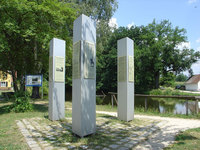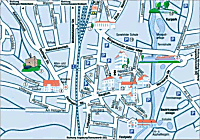The Fossa Carolina(2)
An exhibition on the Fossa Carolina is located in a former barn in the village and is well worth a visit. It was installed for the 1200 year anniversary of the Fossa Carolina which occurred in 1993.
The earliest written reference to the Fossa Carolina can be found in the Annals of Lorsch. This account apparently goes back to the imperial archives, which were officially recorded. They describe Charles’ journey to the Fossa between the Altmuehl and Rezat rivers and further on to the river Main to Wuerzburg. An extended visit by the court to the building site is explicitly mentioned.
The area between Weissenburg and Eichstaett played an important role in Charles’ imperial politics. After the downfall of the Bavarian duke Tassilo III in 788 Bavaria was annexed and became part of Franconia; a regional plan was established and the building of new villages began.
Well-fortified settlements were built forming a half-circle from the Franconian royal court in Weissenburg to Eichstaett (which in those times was the Franconian bishop’s seat) to the former Bavarian duke court of Tassilo in Neuburg on the Danube. This was done to ensure the union between Bavaria and the Franconian state. The Fossa Carolina was probably built for the same reason. A continuous waterway between the heartland of the empire and the Danube would have strengthened the attachment of Bavaria to Franconia; but the Fossa Carolina could also have been intended as a transport link for trade.




